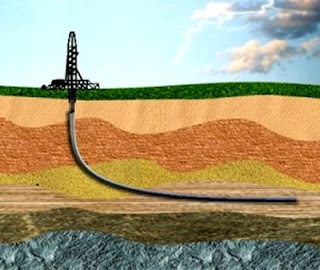 |
| horizontal drilling |
Before we get to Mary's amazing blend of ignorance and dumbassery, we'll be happy to provide a quick definition of the topic:
Horizontal drilling is the practice of turning a wellbore parallel to bedding so as to increase the length of penetration within a reservoir. It is most frequently used for thin or naturally fractured reservoirs, and has often been combined with hydraulic fracturing to increase production from low-permeability reservoirs such as shale.
Given that McMahon (back when she called herself S. E. Smith) had to reach some site-mandated "sweet spot" SEO-wise, i.e., a minimum word count; we're pretty certain that those 51 words would never have cut it with WiseGEEK or with Mary's "editor," Kristen Osborne. No, she had to pad it out and pad it she did, ending up with almost 450 words of text.
The problem? A lot of those words were... well, wrong. Take, for instance, these assertions:
- "Horizontal drilling is a technique for oil and natural gas extraction involving a well dug parallel to the wellbore..." – Yes, Mary did say "parallel to the wellbore" when she actually meant perpendicular. And while we're on this sentence, no one "digs" oil and gas wells; they drill them.
- "In horizontal drilling, workers start by going into the earth at a low angle, gradually increasing the angle to hit the target." – Workers don't "start... at a low angle" and they don't go "into the earth"; drillers start boring a hole a foot or so in diameter (too small to climb down) at or near vertical; the highest angle.
- "[A] mud motor... works through the substrate, dragging the piping along with it." – First, no one in the business would ever call a drill string "piping" and second, the mud motor doesn't "drag" anything. The weight of the drill string – you know, all that pipe – is more than sufficient to push the drill bit forward.
- "For some deposits of natural resources, traditional vertical wells are not practical. When deposits are shallow, it can take an extended period of time for deposits of oil to move towards the borehole." – We aren't sure, but we think our nominee was talking about thin reservoirs, not "shallow" ones. But who knows what dumbassery lurks in the brain of Mary?
- "In the case of a relief well, horizontal drilling creates a method for accessing the area without disturbing the original well and risking a blowout while drilling." – Why wiseGEEKs (and eHowians) insist on bringing up relief wells every time directional drilling is mentioned is beyond us, but we should point out that a horizontal relief well is quite unlikely.
For these statements and a host of other misinformation, it's our solemn duty to inform Mary that she's picked up yet another Dumbass of the Day award. By our count, this is number sixteen and the fifth time she's displayed her ignorance of the petroleum industry. Feh.
SE - OIL
No comments:
Post a Comment